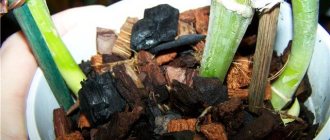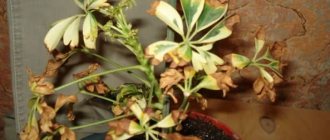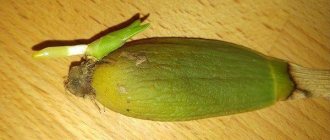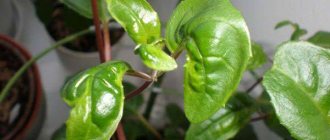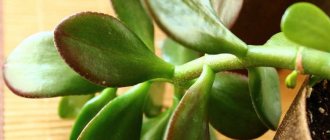Microclimate disturbance
In the vast majority of cases, the deformation of orchid leaves is a response of the plant to the conditions of its maintenance, or rather, to mistakes in care . As practice shows, achieving perfection without taking into account the developmental characteristics of a particular plant is not realistic.
Possible causes of leaf deformation in an orchid due to non-compliance with maintenance conditions:
| Causes of sheet deformation | Errors in care | Control and prevention measures |
| Hypothermia | Draft, drop in average daily temperature below +12-15°C | Restore the optimal temperature regime, treat the plant with the anti-stress drug “Kendal” or “Zircon” |
| Thermal shock | Perhaps the leaves touch the window glass, the surface of which is cold in winter and hot in summer | Move the pot to the edge of the window sill, create a barrier between the glass and the plant |
| Oxygen starvation of the root system | Lack of air access to the roots due to increased density and humidity of the substrate | Adjust watering, replace the decomposed substrate with fresh and loose one |
| Nitrogen, potassium or phosphorus starvation | Lack of mineral nutrition | Fertilize regularly, choosing special fertilizers for orchids |
| Dry air | Reducing atmospheric humidity below 40% | Monitor air humidity |
Curling of leaves, accompanied by loss of turgor, is usually caused by a lack of moisture.
Household air humidifiers help maintain humidity at an optimal level for orchids. If it is not possible to install such a device, you can increase atmospheric humidity using the following methods:
- place the pot with the plant in a tray with wet filler (expanded clay, pebbles);
- cover the orchid with damp moss;
- regularly irrigate the foliage with a fine spray, avoiding moisture getting on the flower stalks and in the axils of the leaves;
- place the plant next to an aquarium or decorative fountain.
Is excess nitrogen always good for the plant?
In order for the green mass to actively grow, the orchid needs nitrogen . But novice gardeners often overfeed the plant, which negatively affects the health of the orchid. Excess nitrogen manifests itself as:
- unusually fast growing orchid;
- softening and cracking of tissues;
- leaf curling;
- short flowering or its absence for 2-3 years.
Plants overfed with nitrogen are often susceptible to various diseases and pests . If, in addition to curling of the leaves, the orchid exhibits other signs of overfeeding with nitrogen, then it is time to adjust the fertilization regime.
Light intensity
When growing indoor orchids, sunlight plays a key role . All kinds of diseases and developmental disorders, including leaf deformation, arise due to improperly organized lighting conditions.
- Inconsistency of lighting intensity with the biological characteristics of the plant . Orchids are divided into shade-tolerant (Phalaenopsis, Cambria) and light-loving (Vandas, Cattleyas, Cymbidiums, Angrecums), and require an appropriate approach to choosing a place of growth - on the shady or southern side of the room.
- Exposure of the plant to direct sunlight . Even light-loving orchids only require diffused light.
- Reducing daylight hours. The optimal duration of lighting is at least 12 hours, and for young plants 16-18 hours a day. In the dark season, artificial lighting is necessary.
I would like to draw the attention of orchid lovers to the fact that the fact that an orchid belongs to the light-loving group does not mean that it can withstand direct sunlight. An orchid should be accustomed to the spring sun gradually. Already in March, plants located on windows with southern and southeastern exposure need to be shaded. When the plant adapts, it will be enough to lower the curtains or close the blinds only during the midday hours.
Author of the book “Caring for Indoor Plants” Elena Ustinova.
What to do if the leaves curl, wither and die?
As soon as the diagnosis has been made and treatment has been carried out, the plant is provided with optimal conditions and care:
- For orchids, places that receive diffused sunlight are comfortable. Direct exposure to sunlight causes burns on the leaves. During periods with short daylight hours, lighting must be extended to 12 hours using a phytolamp;
A phytolamp will help an orchid with a lack of natural light. - The optimal summer room temperature is from 15 to 30 degrees, winter – 20-23 degrees. Changes in daily temperature between day and night within 3-5 degrees stimulate plant growth and peduncle formation;
- The orchid should be watered no earlier than the top layer of soil dries out . In summer, watering is usually done up to two to three times a week, in winter - every 10 days. But the main sign that one focuses on when watering is the dryness of the surface layer of the substrate;
- Fertilize the orchid only during the period of active growth . To prevent root burns, fertilizing is applied immediately after watering. In the growth phase (spring, autumn), the orchid is fed once every 2 weeks, in winter and hot summer - once a month. Read more about when to feed an orchid here.
Proper care for one to two months will get rid of the problem of leaf curling.
Watering mode
Curling of orchid leaves can be caused by improper watering.
Important! The watering regime means not so much compliance with a certain time interval, but a dosed supply of moisture in accordance with the physiological state of the plant.
The frequency and abundance of watering is influenced by several factors:
- looseness, breathability and moisture capacity of the substrate;
- indoor air temperature;
- size of pot and root ball;
- atmospheric humidity;
- physiological state of the plant (stage of intensive growth or dormancy).
That is, the watering regime for each specific specimen is selected individually. The general recommendation is to prevent both the substrate from drying out and water from stagnating in the roots.
How to restore leaf tightness after drying out an orchid?
If an orchid is overdried, it looks lethargic and drops its leaves. Depressed grooves or stripes and wrinkles form on the leaves.
You need to understand that it is necessary to solder the orchid gradually .
If you give an orchid enough water, then the cells become so filled with water that the leaf may burst. Such leaves bifurcate.
1. If the orchid grows in the bark, then it is enough to water it using the pouring method, and the next day soak it for a few minutes. In the future, water in the usual way, but without prolonged drying. Learn more about proper watering.
2. If the orchid grows in a moisture-intensive substrate, for example, in moss or peat, then it is necessary to seal it longer: pour a teaspoon of water into the moss, and after a few hours a few more tablespoons of water. The next day after such minor watering, the leaves should perk up and rise a little.
Damage by diseases and pests
Orchid leaves can curl when attacked by sucking and gnawing parasites. Sheet deformation is caused by:
- spider mite;
- aphids;
- scale insects;
- nematodes.
It is necessary to regularly inspect the leaf axils and the inner surface of the leaf blades in order to promptly detect pest infestations . At the slightest suspicion, the plant should be treated: against sucking and gnawing parasites - with insecticides, against spider mites - with acaricides. Nowadays there are powerful joint-action drugs on sale that can destroy all pests at once. It is advisable to choose products specifically marked “for orchids”.
Ulcerations, spots, various damage against the background of leaf deformation are a sign of damage to the plant by parasites and diseases.
A plant affected by pests becomes defenseless against bacterial and fungal infections, which in turn negatively affect the appearance of the plant.
The effect of abundant watering on the plant
Excessive watering causes rotting of the root system, which means the orchid leaves also suffer. The only correct solution is to adjust the watering regime, and if the roots rot, replant the plant.
What pests cause orchid leaf blades to curl? Methods of struggle.
If the leaves fall, turn yellow or curl, the likely cause may be insect pests - greenhouse (tobacco) whiteflies . If you suspect an infection, you need to inspect the inside of the leaf , it is there that you can find these small midges, visible to the naked eye, no more than three millimeters in size.
Whitefly.
Even if no traces of insects are visible , it is worth treating the plant with insecticidal (against harmful insects) and acaricidal (against spider mites) preparations.
Attention! On the modern market there are effective means of complex action that help eliminate various pests at the same time.
Such drugs include, for example, Fitoverm:
- spraying with insecticides is carried out 2 times a week;
- treatment is carried out until complete removal of adults, their larvae and eggs.
Taking care and proper care of your orchid will make it easy to get rid of a variety of pests and diseases .
State of the root system
The appearance of the leaves directly depends on the condition of the root system. Roots can suffer from all kinds of rot and fungal diseases caused by both excess and lack of moisture. Overheating and hypothermia of the substrate also negatively affects the development of all parts of the plant.
The appearance of the plant depends on the condition of the root system.
Tip #1. To prevent the orchid roots from suffering from hypothermia, you need to use only warm (2-3 degrees above room temperature) water. It is advisable to place insulating material under the pot, for example, polystyrene foam, a board or a rug.
Increasing plant resistance to pests and infectious diseases
The best prevention of infectious diseases and pests is proper plant care. To increase the immunity of orchids, you can purchase drugs Epin, Ecosil, etc. in specialized stores.
Their action is directed:
- to stimulate the development of the plant root system;
- developing immunity to diseases and pests, protection from stress (temperature changes, waterlogging, etc.);
- stimulation of shoot growth in old plants.
Compliance with all the rules for the care and maintenance of an orchid in an apartment is a guarantee of its health and lush flowering .
Unbalanced feeding
The reason for curling of orchid leaves may be the use of fertilizers that are unbalanced in the content of essential nutrients. In particular, deformation of leaf tissues is caused by an overdose of potassium and nitrogen. The orchid should be fertilized with products developed specifically for feeding orchids in the dosage recommended by the manufacturer.
| Name | Composition and principle of action | Release form | Average cost of packaging, rub. |
| "Agricola" for indoor orchids | Complex, chlorine-free, water-soluble fertilizer, balanced in the amount of macro- and microelements, has a positive effect on growth rates and green mass gain | Dry powder in bags of 25 g | 20-35 |
| Pokon | A universal fertilizer with a full set of necessary elements, contains a humic extract that regulates the acid balance of the soil and improves the absorption of nutrients by the plant. | Plastic bottle with suspension 250 ml | 200-250 |
| Bona Forte | In addition to NPK, it contains vitamins, groups B, C and P, the saturation of which allows the plant to withstand stress, painlessly tolerate incorrect watering regimes, low humidity, lack of light and even drafts | 250 ml plastic bottle with water-soluble liquid | From 120 |
| "Mr. Color" | In addition to the standard set of NPK, zinc, manganese, it contains vitamins B and PP, amino acids that stimulate growth and maintain leaf turgor, increasing plant immunity | 300 ml bottle of water-soluble liquid | 35-40 |
For ease of use, the Pokon bottle is equipped with a dispenser.
What to do?
The appearance of an unhealthy leaf can itself tell about the disease that has affected it. Various negative factors each have their own effect on the condition of the leaf plate. So most often the problem can be identified by carefully examining and feeling the leaf.
Methods for eliminating painful conditions also vary. Therefore, in order to understand how to act in a particular case, you need to know what these or those symptoms mean and what causes them.
If the leaves curl?
To return the leaves to their normal shape, you need to find out why the deformation occurred. Causes of leaf curling can be:
- insufficient watering;
- low temperatures;
- frequently turning the pot towards the sun;
- dry air;
- excess or lack of fertilizers;
- attack of whiteflies, aphids, scale insects.
To revive the plant, it is necessary to treat it with insecticides and organize a normal watering regime without fertilizers. Place the plant in a warm and humid place, perhaps with artificial light, for 10-12 hours.
What if they start to crack and burst?
Orchid leaves can crack only in two cases. Either this is mechanical damage or a violation of biochemical processes.
If the first is excluded, then the second may be due to:
- excess or lack of fluid;
- oversaturation with nitrogen;
- overdried root system;
- sunburn;
- root system problems.
To restore leaf blades, it is necessary to normalize the watering and fertilizing regime. Remove the plant from the sun and carefully examine the condition of its root system.
If they're flabby?
Flabbiness of the leaves is one of the signs of an unhealthy flower. Factors that cause sagging are most often:
- violation of watering rules;
- overheating of roots;
- root damage;
- increased soil density.
To cope with the problem of sagging leaves, you should adjust the plant’s drinking regime and regulate the temperature situation. Carry out a thorough inspection of the substrate and root system, and replant if necessary.
If they split?
Forking a leaf in an orchid is quite rare. There are also few reasons for this: either it is the incorrect growth of the new leaf, due to its attempts to stretch towards the light source. Or perhaps this is a consequence of an overdose of nitrogen, which leads to various deformations.
In order for the leaf to have a normal shape, it is advisable to unfold the pot so that the light falls from the desired side. The feeding schedule should be reviewed.
What if you got sunburned?
Sunburn occurs in a fairly short time, so leaving the flower in the sun, especially in spring or summer, even for a short time, is not recommended.
Symptoms of sunburn:
- increase in temperature of the sheet plate;
- lightening leaf color;
- the appearance of pigmentation and spots with a brown edge.
If the burns are severe, the leaf is cut off; if there are not very many marks, then you can leave it and observe it. If completely yellowed, it will have to be removed. Fertilizing during recovery should be excluded, watering should be limited, and diffused light should be provided.
What if they become soft?
Soft leaves are a fairly common problem in orchid plants. The main reasons for softness are:
- problems with watering;
- diseases of the root system;
- tick invasion.
To restore the elasticity of the foliage, it is necessary to normalize the watering system. Carefully inspect the plant for parasites and rotting of the root system. Carry out the necessary treatment.
If small leaves don't grow?
There may be several reasons for the lack of leaf growth. The most important negative factors are:
- improper watering;
- incorrect temperature conditions;
- insufficient lighting;
- unsuitable humidity level;
- lack of potassium and phosphorus.
To stimulate leaf growth, it is necessary to normalize the main indicators of the orchid's conditions. Feed the plant foliar.
Errors in keeping orchids
- Considering that orchids cannot develop harmoniously without sufficient lighting, gardeners install artificial lighting above the plant. The main mistake is that the height of additional lighting fixtures often does not correspond to the norm. To avoid thermal burns, the distance between the lamp and the surface of the last growing leaf should be at least 30 cm. It is better to choose new generation lamps for illuminating orchids.
- On various amateur forums, you can find advice from “experts” about turning the orchid pot as often as possible in order to ensure access to sunlight to all parts of the plant. It is precisely this tactic that leads to leaf twisting. The fact is that the upper surface of the leaf plate is involved in the process of photosynthesis. If you turn the back of the orchid towards the light, the plant will begin to turn the leaf inside out to expose the upper surface of the leaf plate to the sun's rays.
Prevention
The process of restoring a flower should begin by moving it. If a flower is, as they say, “out of place,” then it needs water treatments. To begin, water by immersing the pot in a container of warm water. Let the flower stand in the water for about an hour. Next, give the plant a warm shower. Be careful: water should not get on the flower stalks. After the bath procedure, the leaf plates should be wiped dry with a cloth made of natural material. Place the orchid in a warm place, but not in direct sunlight, so as not to cause a burn. At this time, it is not recommended to water the flower with growth agents, otherwise the situation can only worsen.
After three days, symptoms should begin to improve. If this does not happen, you should deal with the roots. The plant needs to be removed from the pot and the root system carefully examined. Healthy roots will be bright green. All dried and rotten roots are removed with a sharp knife until healthy tissue is removed. After this, the cut area is sprinkled with charcoal or activated charcoal.
The orchid is not only a beautiful, but also a very capricious flower. Failure to follow the rules of care can cause the leaves to wrinkle and lose their shine. The main thing is to place the flower in a well-lit place, water it, checking the soil moisture, replace the substrate when replanting and treat it in a timely manner against pests.
Similar articles
Why do orchid leaves turn black and how to stop it
What to do if all the leaves of an orchid have fallen off at once
What to do if the baby orchid is still without roots
The problem of aerial roots in an orchid and what to do about it
Answers on questions
Question No. 1. Phalaenopsis leaves are curled, but the plant looks healthy. What could be the reason for the deformation?
For some varieties and hybrids of Phalaenopsis, for example, Phalaenopsis Sweet Memory, this condition is not an anomaly. Some leaf bending or drooping to one side is normal, as long as the plant remains green and does not refuse to bloom.
The curling of leaves of some Phalaenopsis varieties into a tube may be a species feature and not an anomaly in the development of a particular plant.
Basic orchid care in detail: watering
Quite often, spots appear on the leaves, buds and peduncles of orchids, the leaves curl, and other symptoms appear that are trivial care errors.
Let's look at some of them and the reasons for their appearance. Orchids, for the most part, come to us from tropical and subtropical parts of our planet. Quite often, damage to these plants occurs due to care errors. Of course, when a plant begins to feel unwell, wither, leaves droop and the plant looks unhealthy, we try to find the reasons? and most often all kinds of diseases, pests, and even viruses come to our minds. But often the reason is much more banal and everything can be fixed quite easily. Some symptoms are very similar, for example, it is not always easy to distinguish a viral disease from mesophyll cell collapse, which is a consequence of a bacterial infection, and it, in turn, is easily confused with stains resulting from exposure to cold water. In any case, it is important to analyze the care, changes in care, temperature and light conditions in order to make the right decision and save the plant. When unusual lesions appear on orchids, this does not always mean that the plant is sick. Understanding the life cycle of plants will help you understand and distinguish natural processes from disease. For example, at the end of the growth period, Malaxis Lafifolia is a pitiful sight of drooping, as if dried leaves, and this is not a disease, but just a normal process of the life cycle of this orchid. Next, we will try to figure out which physiological problems are actually a natural process in the cycle of a particular plant, which are the result of care problems, and which are more serious problems. Let's start with water.
Watering
Excessive watering is the most common cause of death of orchids. An even more common cause of death is a combination of several factors, when, as a result of weakening of the plant as a result of increased watering, the plant develops, for example, a secondary bacterial infection and the plant dies.
Signs of overwatering on phalaenopsis roots
The first signs of overwatering on phalaenopsis leaves
The roots of the phalaenopsis have died and can no longer deliver food to the leaves - the leaves have begun to wither.
Death of phalaenopsis due to elevated temperatures and waterlogging.
Rotting caused by excess water on cymbidium
Excessive moisture on cattleya
How to avoid maintenance mistakes and choose the right watering scheme? First, you need to understand that different types of orchids have different requirements for watering and it is important to study these requirements, to understand whether this orchid needs to have a dry dormant period or, on the contrary, any drying out of the substrate can lead to to sad consequences. Orchids of any type - both epiphytic and terrestrial - can be planted in different containers and in different substrates, and all this directly affects the frequency of watering. The substrate of plants planted in clay pots dries out many times faster than the same substrate in a plastic pot, since due to the natural pores, the clay pot “breathes” and is saturated with moisture faster but also evaporates it faster. A plant planted in a hanging basket dries out faster than the exact same plant planted in the same substrate, but in a clay pot, or even more so in a plastic pot. In turn, plants on a block dry out much faster than plants in a hanging basket. Based on this, we regulate watering: Orchids planted on blocks without or with a minimum of substrate and do not require a period of rest, water frequently and abundantly, daily lowering the plant into a container of water. When the air humidity is 80-90%, we water it once every 3-4 days, also by lowering the plant into a container of water. Orchids planted in clay pots in a moisture-intensive substrate (for example, a substrate with a high content of sphagnum moss) are watered less often than a plant in the same pot, but for example in a substrate made of coarse bark. And we least often water plants planted in a moisture-intensive substrate in a plastic pot.
As it became clear, an important factor influencing the frequency of watering is the type of substrate in which you decide to grow your orchid. Each type of substrate dries out at a different rate, and if orchids planted in pure sphagnum moss need to be watered quite rarely, then orchids planted in large particles of bark need to be watered much more often.
Quantity and quality of irrigation.
The plants are watered in such a way that the water begins to flow freely from the pot a few minutes after watering. The next watering is required when the surface of the substrate is dry or slightly damp to the touch, for orchids that cannot tolerate drying out the substrate. If you are not sure, cut a piece of bark and see if the inside is dry or wet. You can use the “pencil method” - lower a sharpened pencil into the substrate for 10 seconds. If, when you take it out, the lead and even the wood are wet, there is no need to water the plant under any circumstances. If the lead has darkened, the plant is watered normally, watering will be required in 1-2 days, but if the lead is completely dry, the plant requires immediate watering. With experience, learn to determine the dryness of the substrate without such procedures. There is a golden rule - if you are not sure whether to water an orchid today, water it tomorrow. It is especially important to follow this rule for plants planted in moisture-intensive substrates, such as sphagnum moss or fine bark. If we do not allow the substrate to dry out between waterings, the orchid roots will begin to lack oxygen and this will affect young growth or new leaves. For example, a substrate with a high content of moisture-intensive components, if overwatered, will not contain the oxygen that the roots need, which will inevitably lead to root rot and ultimately the death of the plant. In nature, the roots of epiphytic plants are constantly exposed to the air, receiving the necessary moisture from the air and tropical rains. They also dry out periodically. Therefore, plants that are constantly flooded are damaged, and often without a chance of recovery. The other extreme is complete drying of the substrate. Complete drying out can occur as a result of too infrequent or scanty watering, or if the substrate contains too few moisture-intensive components. Since the most common substrate for planting orchids is a mixture of bark and moss in various proportions, the water-holding capacity of such substrates is usually sufficient. To increase moisture capacity, finely chopped foam is sometimes added. But even the most balanced substrate is very difficult to re-hydrate if it dries out. Such a substrate does not retain moisture; when watering, water immediately flows out of the drainage holes of the pot without saturating the substrate. If the situation is not urgently corrected, the roots will die and die without moisture, the plant will begin to wither and some of it will no longer be possible to save. Damage to the plant in this case looks completely identical to damage caused by overwatering the plants, except that in case of overwatering, an unpleasant mushroom smell emanates from the substrate and the substrate itself may become covered with mold or moss. The dried substrate needs to be moistened by thoroughly pouring it several times at short intervals. You can also try to saturate such a substrate by immersion, but often the dried bark floats up, and the plant seems to be “pushed” out of the pot. The most gentle and effective way in such situations is to water the plant, previously placed in a deep container, with warm water and leave it there for 30-40 minutes. Afterwards, be sure to drain the excess water so that it does not stand in the pan. Repeat the procedure several times until the substrate is evenly moistened and saturated with water. Drying out of the substrate can be avoided by frequently spraying the plant or just the substrate between waterings. Water quality
Today, most hobbyists use tap water to water orchids. In most cases, this is justified, but it is necessary to settle the water, and soften too hard water! Most often, problems arise with excess salts, which accumulate both on the surface of the substrate, clogging the pores of the roots, preventing them from breathing, and on the surface of the leaves.
